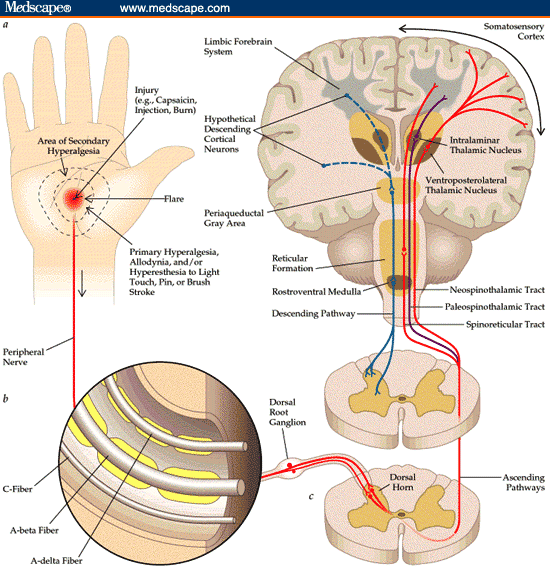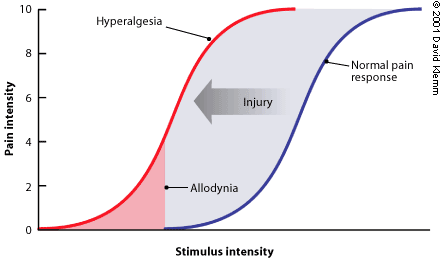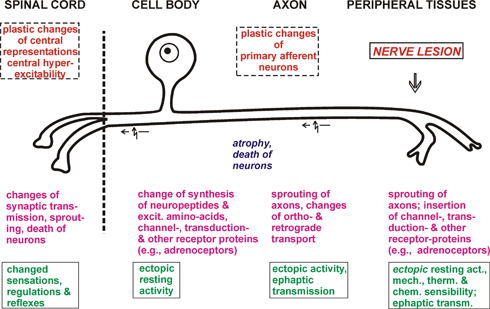There are many types of pain, and a lot remains to be discovered about the nature of chronic pain. The information below deals with the changes that occur in nociceptive afferents and in ascending nociceptive pathways in some experimental models of chronic pain. The diagram below shows the effects of a small burn to the skin. The area around the burn becomes extremely sensitive, due to the sensitization of nociceptors. A second area of uninjured tissue surrounding the burn is hypersensitive due to a process of secondary hyperalgesia; allodynia is present (i.e. pain is induced by light stimuli that would not normally be painful. This hyperalgesia is thought to be due to plastic changes in the dorsal horn that result in a strengthening of the nociceptive message. This is associated with several changes in the primary afferent, including the expression of a additional types of voltage-sensitive sodium channel including one that is insensitive to Tetrodotoxin. This channel inactivates slowly and differences in the gating and expression of these sodium channels are likely to alter the generation and propagation of action potentials in nociceptive neurons, and transmitter release. The bottom diagram summarises some of the changes in nociceptive afferents in experimental neuropathies. |
|
 |
|
|
Primary and secondary hyperalgesia After a tissue injury, the area around the injury becomes hypersensitive and light touch can elicit pain. There are two aspects to the hyperalgesia: primary hyperalgesia is defined as the hypersensitive area at the site of the injury. It is due to an 'inflammatory soup' of endogenout algesic agents. Secondary hyperalgesia develops in uninjured tissue surrounding the site of injury, and is thought to be a result of sensitization in the central nervous system, including the dorsal horn. The diagram opposite indicates that mechanisms that increase synaptic strength within the dorsal horn may be responsible. Upregulation of the production of peptide neurotransmitters, changes in gene transcription in the cells of the dorsal horn and changes in the effects of descending contol pathways may all play a part in the responses. The lower diagram opposite indicates that in hyperalgesic states there is a leftward shift in the stimulus response curve, indicating that pain is induced at lower stimulus intensities. Allodynia is the mild pain that is present in response to light touch stimuli, and hyperalgesia is the hightened response to a painful stimulus.
|
|
|
Voltage-gated Sodium Channels (Nav channels).
There are several types of voltage-gated sodium channels including several in the brain and sensory neurones; the family is given the name Nav1.n where n is a number that refers to a specific isoform. Nav1.7 is voltage-gated sodium channel commonly found in nociceptive and autonomic nerves, and is sensitive to tetrodotoxin (TTX, a poison extracted from Puffer Fish, and used by them to paralyse their prey). Nav1.8 is a TTX-resistant voltage gated sodium channel which is present in C-fibre afferents in some experimental neuropathies, and in a significant percentage of humans with persistent chronic neuropathies. Nav1.8 is known to be involved in hyperalgesia and allodynia in experimental investigations; studies of Nav1.8 knockout mice have shown that the channel is associated with inflammatory and neuropathic pain, and particularly with cold pain. Nav1.9 is another voltage-gated sodium channel, thought to carry a persistent, TTX-resistant voltage-gated sodium current, that appears to be related to hypersensitivity to heat and mechanical stimuli in inflammed tissues. The expression of some of these isoforms seems to be related to the existence of inherited neuropathies/pain syndromes. |
|
|
Biochemical, anatomical and physiological changes of lesioned primary afferent neurons following nerve lesion and the subsequent central changes.
(http://www.physiologie.uni-kiel.de/homepages_mitarbeiter/jaenig/neu/hompage.html) This diagram show some of the changes that contribute to the development of chronic pain, and appear to be relevant to the neuropathic pain that occurs after nerve injury. See the section of Phantom Limbs. |
|


